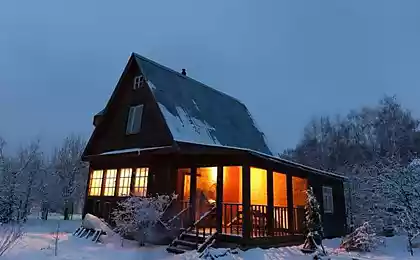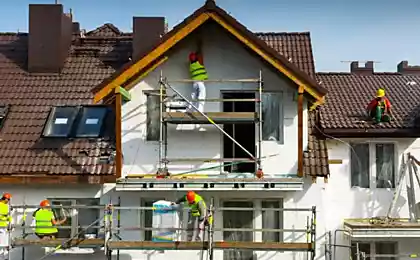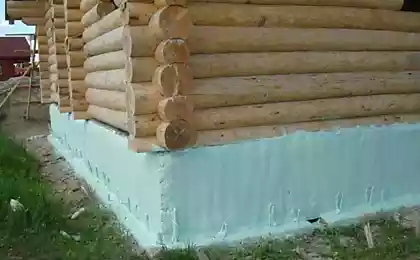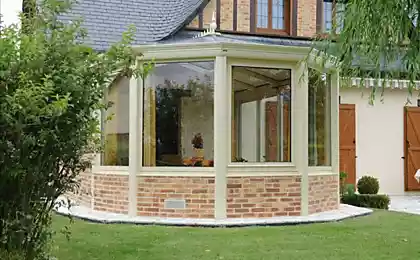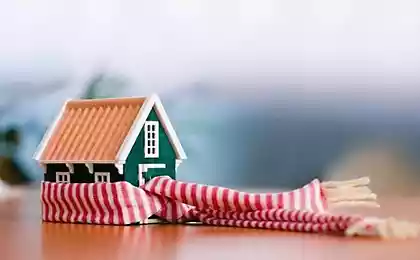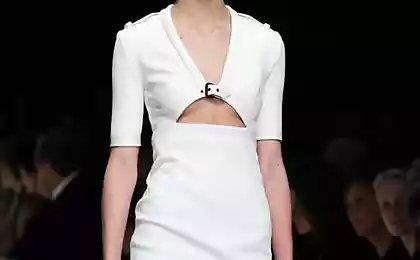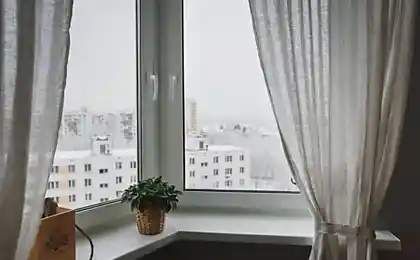601
How to insulate an already built house
There are situations when you just built the house not passed the test of winter, it was cold and not comfortable. What to do? To run the heaters and spend considerable amounts on your energy bill? Do not rush, because there are other ways.
The first rulethat must be remembered to everyone who decided to start winterizing your home, is that necessary to insulate the outside exclusively, because of the insulation of the house on the inside do more harm than good.

Here is a simple example. To build a brick house, and then take it from the inside and insulated with polyurethane foam. The first question that arises is, why build a house of brick, then to live, in fact, in polyurethane foam? Besides, if the house is insulated on the inside, the brick in the winter time will freeze and thaw will then be until mid-summer. Then it is necessary to build a house out of plywood, insulate it with polyurethane foam — the same effect happens, but costs significantly less.
So if you decide to insulate your brick home, then this should be done only from the outside — brick-the cold comes and it keeps accumulated during the summer heat. Plus much less fuel to heat the home will have to spend.
Remove the wind loadthe Second rule. What else should I do to in the winter the house was warmer? We must try to reduce wind load. How to block the path of the wind directly to the wall? There are several ways. If the finances are no problem, you can buy ventilated facades, the solution, though not cheap, but effective, and over time will be repaid many times. If you want a more budget option, you can remember the old, but proven way is to sheathe the walls of the house with boards, then the boards, you can even make cheaper — obbit wall with roofing material.

So heat is not blown from a wooden house, you can seal cracks and grooves between the logs with a special mastic. For brick homes or buildings, concrete is used the thermal point. This option, incidentally, is more economical in comparison with ventilated facades. Experienced builders suggest the thermal point "isollat" Ekaterinburg production.
Put it on the wall with a brush, it looks like the walls are smeared with sour cream. Three or four times to paint such a thermal point of the wall, and the house will be much warmer. To do all this better in the summer, in dry and warm weather (if you perform work in the rain, paint will wash off because it is water-dispersed basis). But if there is a need to perform these works in the winter, there are paints that can be applied to walls even at -5 degrees outside. By the way, after drying, "isollat" on any surface except glass and plastic is kept so that scraping it very difficult.
Warm floor will warm the whole houseoutside Walls insulated, wind load was removed, it is now possible to look inside the house. Here the solution of the problem of heat insulation is better to start with the installation of Underfloor heating. Many experienced builders recommend to pay attention to infrared film warm floors. Take a little bit of electricity, installation is simple plus you can mount under different types of flooring under laminate, tiles, linoleum and so on.
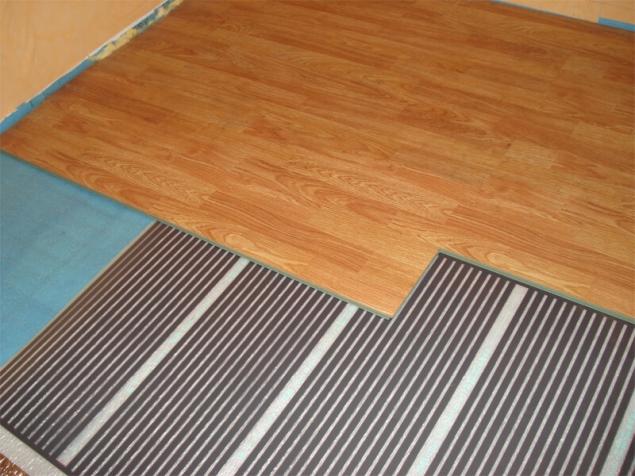
Currently, there is a "Infrakrasnye", which are hung on ceilings, they are good and economical, the only negative when you are constantly beneath them, the feeling that the sun bakes the head. Infrared warm floor is slightly warm feet, it's pleasant and not very expensive. For example, for heating infrared Underfloor heating well insulated home in the 100 squares, the owner will pay slightly more than 2 thousand rubles in the coldest month.
Someone will say that heated floors are not cheap — it is, but if you compare these costs with the costs, such as solid fuel boiler, the floors are even a little cheaper, but in operation much cheaper.
In conclusion, a few tips on the subjectIn the event of a power outage it's nice to have in a country house a backup source of heat, even the simplest, such as the cast-iron stove. Moreover, make them now visually appealing, they have a lot of places do not occupy, weigh relatively little.
Comfort can be seriously affected, if you freeze water or Sewerage. To avoid this, the inputs and outputs necessary to insulate and bury. If the tubes are not really recessed and not insulated, it will save the heating cable. Electricity he takes a bit, on the small. If the water comes from a well, it is also necessary to insulate. The mass of options, even banal sawdust in plastic film.
Someone who uses gas cylinders must be remembered that cylinders with a capacity of 50 l have to stand outside in metal cabinets, otherwise made of frost in the winter in the home containers can explode due to simple thermal expansion.
If the Foundation of the house not buried at 1.8 m, it is necessary to take care to avoid freezing. Soils "pouchatsya" in the cold waterlogged after a heavy fall. The house can just "break." To counter this, it is necessary to do the drains, wide pavement, if you do not have time, to organize a superficial drainage system and insulation of the Foundation in any way until dusting it with snow.
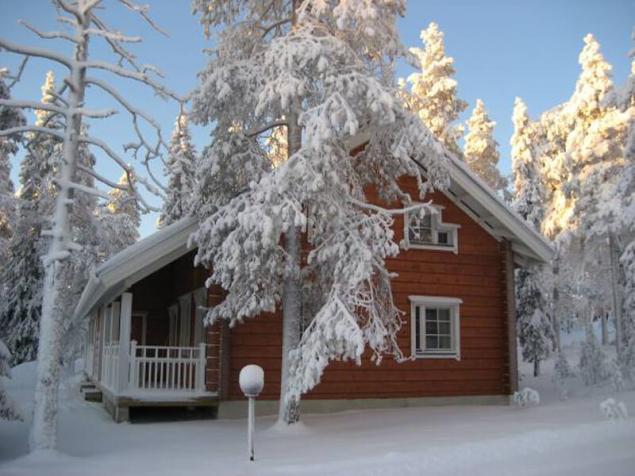
Here are some practical tips that will surely help return warmth to your home!
Source: estp-blog.ru/rubrics/rid-37097/
The first rulethat must be remembered to everyone who decided to start winterizing your home, is that necessary to insulate the outside exclusively, because of the insulation of the house on the inside do more harm than good.

Here is a simple example. To build a brick house, and then take it from the inside and insulated with polyurethane foam. The first question that arises is, why build a house of brick, then to live, in fact, in polyurethane foam? Besides, if the house is insulated on the inside, the brick in the winter time will freeze and thaw will then be until mid-summer. Then it is necessary to build a house out of plywood, insulate it with polyurethane foam — the same effect happens, but costs significantly less.
So if you decide to insulate your brick home, then this should be done only from the outside — brick-the cold comes and it keeps accumulated during the summer heat. Plus much less fuel to heat the home will have to spend.
Remove the wind loadthe Second rule. What else should I do to in the winter the house was warmer? We must try to reduce wind load. How to block the path of the wind directly to the wall? There are several ways. If the finances are no problem, you can buy ventilated facades, the solution, though not cheap, but effective, and over time will be repaid many times. If you want a more budget option, you can remember the old, but proven way is to sheathe the walls of the house with boards, then the boards, you can even make cheaper — obbit wall with roofing material.

So heat is not blown from a wooden house, you can seal cracks and grooves between the logs with a special mastic. For brick homes or buildings, concrete is used the thermal point. This option, incidentally, is more economical in comparison with ventilated facades. Experienced builders suggest the thermal point "isollat" Ekaterinburg production.
Put it on the wall with a brush, it looks like the walls are smeared with sour cream. Three or four times to paint such a thermal point of the wall, and the house will be much warmer. To do all this better in the summer, in dry and warm weather (if you perform work in the rain, paint will wash off because it is water-dispersed basis). But if there is a need to perform these works in the winter, there are paints that can be applied to walls even at -5 degrees outside. By the way, after drying, "isollat" on any surface except glass and plastic is kept so that scraping it very difficult.
Warm floor will warm the whole houseoutside Walls insulated, wind load was removed, it is now possible to look inside the house. Here the solution of the problem of heat insulation is better to start with the installation of Underfloor heating. Many experienced builders recommend to pay attention to infrared film warm floors. Take a little bit of electricity, installation is simple plus you can mount under different types of flooring under laminate, tiles, linoleum and so on.

Currently, there is a "Infrakrasnye", which are hung on ceilings, they are good and economical, the only negative when you are constantly beneath them, the feeling that the sun bakes the head. Infrared warm floor is slightly warm feet, it's pleasant and not very expensive. For example, for heating infrared Underfloor heating well insulated home in the 100 squares, the owner will pay slightly more than 2 thousand rubles in the coldest month.
Someone will say that heated floors are not cheap — it is, but if you compare these costs with the costs, such as solid fuel boiler, the floors are even a little cheaper, but in operation much cheaper.
In conclusion, a few tips on the subjectIn the event of a power outage it's nice to have in a country house a backup source of heat, even the simplest, such as the cast-iron stove. Moreover, make them now visually appealing, they have a lot of places do not occupy, weigh relatively little.
Comfort can be seriously affected, if you freeze water or Sewerage. To avoid this, the inputs and outputs necessary to insulate and bury. If the tubes are not really recessed and not insulated, it will save the heating cable. Electricity he takes a bit, on the small. If the water comes from a well, it is also necessary to insulate. The mass of options, even banal sawdust in plastic film.
Someone who uses gas cylinders must be remembered that cylinders with a capacity of 50 l have to stand outside in metal cabinets, otherwise made of frost in the winter in the home containers can explode due to simple thermal expansion.
If the Foundation of the house not buried at 1.8 m, it is necessary to take care to avoid freezing. Soils "pouchatsya" in the cold waterlogged after a heavy fall. The house can just "break." To counter this, it is necessary to do the drains, wide pavement, if you do not have time, to organize a superficial drainage system and insulation of the Foundation in any way until dusting it with snow.

Here are some practical tips that will surely help return warmth to your home!
Source: estp-blog.ru/rubrics/rid-37097/



